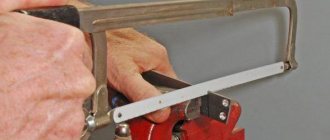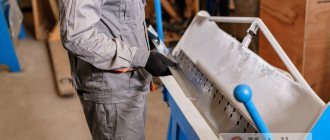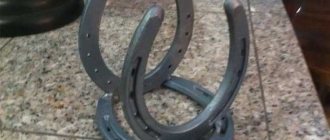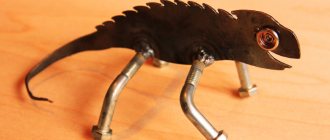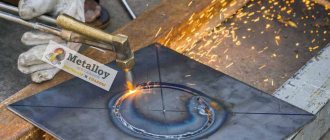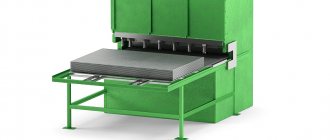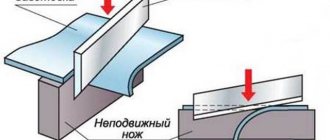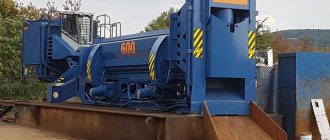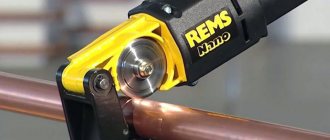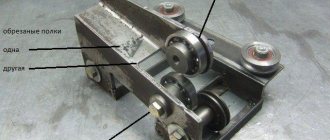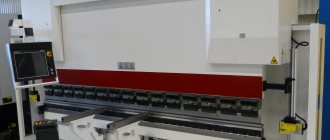Tin works. Filing and cutting metal
Types and sizes of files
Files are cutting tools in the form of hardened steel bars of various profiles and lengths with teeth cut on their working surfaces.
Each such file tooth is a cutter that removes a layer of metal in the form of chips.
The file consists of a working part and a tail part - a shank. In addition, the elements of a file are: nose, edge, edge, heel. A handle is attached to the tail part of the file.
File teeth are obtained in several ways:
Notching on notching machines with a special chisel, milling, grinding and broaching.
Each method corresponds to a certain geometry of the file teeth.
According to their purpose, files are divided into two groups: general-purpose metalworking files, intended for performing various metalworking works on metal; Special, designed to perform various works on metal and non-metallic materials.
Special files are divided into hand and machine.
Files are made with the following types of notches: simple or single; with cross; with arc.
Each type of cut has its own advantages and is used for files for a specific purpose.
A simple or single notch is used in the manufacture of some types of special files (for example, for sharpening wood saws).
It is advisable to use files with a simple notch in all cases when it is necessary to remove a small layer of metal from a narrow work surface.
Cross, or double, notching is used in the manufacture of general purpose files. In these files, the main notch is made at an angle (lambda) = 25º, and the auxiliary notch is made at an angle (omega) = 45º.
Such notch angles provide high productivity.
A point, or rasp, notch is used in the manufacture of rasp files. Rasps with a point cut have large teeth and spacious grooves, which contributes to better separation of chips when filing soft metals, rubber, leather, plastics, etc.
Bench files differ in two main ways: the cross-sectional shape and the number of notches per centimeter of file length.
Bench files are made according to the cross-sectional shape of eight types: flat (type A), flat pointed (type B), square (type B), triangular (type D), round (type D), semicircular (type E), rhombic (type G), hacksaws (type K).
According to the number of notches, machinist's files are divided into six numbers: 0, 1, 2, 3, 4, 5. The notch number is an indicator of the operational purpose of the size range of files based on the pitch of the main notch.
Files with notches No. 0 and 1, the so-called bastard files, have the largest teeth and are used for filing with an accuracy of 0.2-0.5 mm parts that have a processing allowance of 0.5 to 1 mm.
Files with a notch No. 2, the so-called personal ones, are used for finishing filing of parts with an accuracy of 0.02-0.15 mm, while the processing allowance ranges from 0.1 to 0.3 mm.
Files with notches No. 3, 4, 5, so-called velvet, are used for final finishing of parts with an accuracy of 0.01 to 0.005 mm, while the processing allowance ranges from 0.025 to 0.05 mm.
Files are made from tool carbon steel U13 or U13A and are hardened to a hardness of at least HRC 54-58.
Rasps differ from metalworker's files in that they have a notch. They have large, short teeth in the form of pyramids. Thanks to the large tooth sizes and spacious grooves behind each tooth, rasps are suitable for filing soft metals. The rasp teeth are arranged in rows perpendicular to its axis.
Mechanization of filing
Metal cutting
Recently, many representatives of traditional hand tools have successfully transformed into electrical devices with higher technical and operational performance. Plumbing also underwent modernization, as a result of which craftsmen acquired pneumatic devices for filing metal. In general, the concept of manual processing has been retained, but the force is provided by an electric motor. Nozzles with abrasive surfaces also serve as working elements.
In addition to pneumatic tools, cordless and corded tools are also widely used. For example, a band file is equipped with cutting blades that effectively perform accurate and precise finishing of various metal surfaces. The advantages of mechanized devices include processing quality, high speed and process safety. However, high precision when servicing complex-shaped workpieces is still achieved only if traditional files are used.
Metal cutting
One of the methods of preparing a part for finishing is metal cutting. It relates to metalworking operations. Its use allows you to solve the following problems:
- remove the remaining layer or parts of metal from the surface of the workpiece;
- eliminate the formed edges on the edges of the part after forging and casting;
- divide rolled metal into smaller parts;
- cut holes in metal products;
- cut grooves for various purposes.
The reference literature describing plumbing provides in detail the tasks solved by this operation and the methods for carrying it out. The great purpose of the metalworking cabin determines its widespread use in metalworking and mechanical engineering. It allows you to quickly and efficiently separate workpieces into specified sizes.
Metal cutting methods
Metal cutting technology is divided into the following types:
- according to the nature of the tasks being solved (cutting out parts according to a given shape, separating a piece of metal of the required size, cutting out grooves);
- method of operation (manual or mechanized);
- fixation method;
- direction of felling action (vertical or horizontal).
All types of metal cutting can be carried out both manually and mechanically. This is determined by the required quality of the resulting product, quantity (productivity), technical capabilities (availability of manual or mechanical tools).
When manual cutting, the following methods are used: vertical or horizontal. The choice of method depends on the possibility of fixing the metal.
It can be clamped in a vice (if size and weight allow). If this is not possible, the workpiece is placed on an anvil or metal plate. It is advisable to perform a horizontal operation using a bench vice.
When manually chopping, there are three ways to strike with a hammer. These are hand, elbow and shoulder blows. The speed of the operation and the quality of the resulting edge of the part depend on the force of the impact. The force of the blow is influenced by the mass of the striking part of the hammer and the length of the handle.
In equipped workshops and metalworking enterprises, various types of mechanized methods for chopping and cutting metal workpieces are used. These methods include:
- cutting using a press or hammer;
- chopping and cutting using a guillotine;
- use of special machines.
Mechanized types are based on mechanical, hydraulic or electrical principles of operating a cutting tool.
Equipment and tools used
This list depends on the method of work. Manual cutting is carried out using:
A metalworking chisel structurally consists of three main parts: impact, middle (holder) and cutting (working). The shape of the cutting part is different for each and depends on the task being solved. A chisel is used to perform a standard chopping operation. Kreuzmeisel has a narrower cutting edge. The groover is designed for cutting grooves, so its cutting part is made in the shape of a semicircle. The beard is made from a round metal rod, and has a working part in the shape of a circle sharpened around the perimeter. It is used to cut holes in sheet metal. All percussion instruments are made from durable tool steel.
The main parameters of these tools are geometric dimensions and sharpening angles of the cutting part. A plumber's hammer is used to strike the upper (impact) part of the chisel. They differ in the shape of the striker (round or square), the method of attaching the handle, and the total weight.
Cutting out small parts, holes, and individual parts is done using fastening equipment or on steel substrates. To ensure secure fastening, this operation is performed in a vice.
Various metalwork rulers, squares, marking calipers, and small markers are used as marking tools. To make marks, the following are used: cores (of various modifications), scribers with different tip shapes, and pencils. The tools used are manufactured according to developed standards
In industrial enterprises, the tools for cutting metal are special machines. These include:
- guillotines;
- presses (hydraulic and mechanical);
- press shears;
- angle cutting machines.
They have high productivity and allow you to cut even very thick metal.
The hydraulic guillotine is controlled by an electronic unit. With its help, the parameters of the future operation are set. Set the type of metal, the cutting angle, the amount of pressure on the knife, and the cutting speed. In addition to the guillotine, so-called combined units are used to solve these problems. These include cutting machines (press shears) and highly specialized ones (angle notching machines, presses and dies). Press shears are used for cutting sheets and strips of metal, shaped and long products. They work well with profile metal, for example, channel, I-roll, square. With their help, smooth holes and grooves of various shapes are obtained.
Angle notching machines allow angular cutting of metal products of almost any thickness. High precision cutting is achieved thanks to the presence of a scale that allows you to accurately lower the tool to the required place and a correctly sharpened set of chisels.
Presses and stamps solve similar problems. They use mechanical, hydraulic, pneumatic and electric drives.
Manual method of cutting metal
Metalworking techniques determine the sequence of actions:
- securing the workpiece in a vice; if this is not possible, place it on an anvil;
- the chisel is placed at the beginning of the marking line;
- first, preliminary gentle blows are applied with a hammer to highlight the contour of the intended cutting line;
- then a cutting tool is moved along this line and struck with strong blows;
- after completion, the half-cut workpiece is turned over;
- on the reverse side, repeat these steps until complete cutting off.
When working with strip metal, use the horizontal method. The rules of work are as follows:
- When sharpening, the cutting edge of the chisel is given a certain curvature;
- begin to carry out the operation from the far edge gradually approaching the front mark;
- When cutting out blanks according to the established template, an allowance should be provided.
During manual operation, there is a high probability of damage to the workpiece or the appearance of various defects. To avoid this, you must:
- ensure strong fixation of the workpiece;
- observe the angle of the chisel (it should be 30 degrees);
- carefully mark the cutting line;
- It is recommended to chamfer the workpiece before starting work;
- The frequency of blows applied must be uniform with the same force.
These recommendations must be observed especially when cutting metals from the PZO profile.
Cutting metal with a guillotine
At metalworking, machine-building enterprises, and large workshops, mechanized metal cutting is used. The most common is cutting using various guillotines. Mechanization of cutting makes it possible to improve the quality of the chopped edge, cut thicker metal, and increase the speed of obtaining the finished workpiece.
The essence of cutting
Metal cutting is a metalworking operation that allows you to detach unnecessary elements (part, layer or defect) from the main workpiece. It helps to remove:
- scale;
- inaccuracies in dimensions if they arose during the production stage of the product;
- burrs.
You can also divide one workpiece into several different parts.
The process occurs by applying physical pressure through a stronger material. Typically, the blades use tool steel with added carbon, which has undergone additional heat treatment and hardening to increase strength. The iron being processed has a less stable chemical lattice, so intermolecular bonds are broken and non-plastic deformation occurs. Sometimes, to speed up the procedure, the sample is subjected to heat treatment.
Metal cutting
Chopping is often classified as a group of cutting jobs, but in fact, completely different tools are used here, and the possibilities they provide are much wider. Unlike the impact action exerted on the cutter in the previous case, pressure is used when cutting.
Manually
To work with various workpieces the following are used:
- for cutting wire - wire cutters,
- circle, square and hexagon are sawed with a hacksaw,
- sheet materials are cut with scissors.
The use of special equipment can expand the capabilities of metalworking several times.
In industry and mass production
Various types of machines are used in production:
- with hacksaw blades or circular saws,
- turning,
- milling,
- installations for plasma/laser/gas cutting.
The scope of application for these installations, like for hand tools, is quite different.
Hacksaws and circular saws are the simplest types of machines. Their only task is to save time when cutting long products. They can also handle thick workpieces with ease.
Lathes can be divided into models:
In the first case, using carbide cutters of various shapes, a worker manually grinds the required part from a horizontally fixed rotating cylindrical workpiece. In the second, all actions are performed automatically when executing a preloaded program.
The easiest way to understand the principle of use is in this video:
Milling machines perform approximately the same function, but can create products of absolutely arbitrary shape. A rectangular, square or cylindrical workpiece is fixed on a movable table, after which a head with a rotating cutter, following the program, begins to cut off the “extra” metal.
The process looks like this:
For thin and thick sheet metal, a separate group of CNC machines is used. The key difference between them is the technology used for cutting.
The blank sheet is placed on a stationary table, after which the cutting head, controlled by a computer, begins to cut parts according to a predetermined program.
The cutting head can be used for:
This technology ensures maximum accuracy and speed of production, which is highly valued in conditions of mass production.
Its main disadvantage is the likelihood of formation of molten metal deposits on the edges of parts and scale, especially when using workpieces of large thickness.
